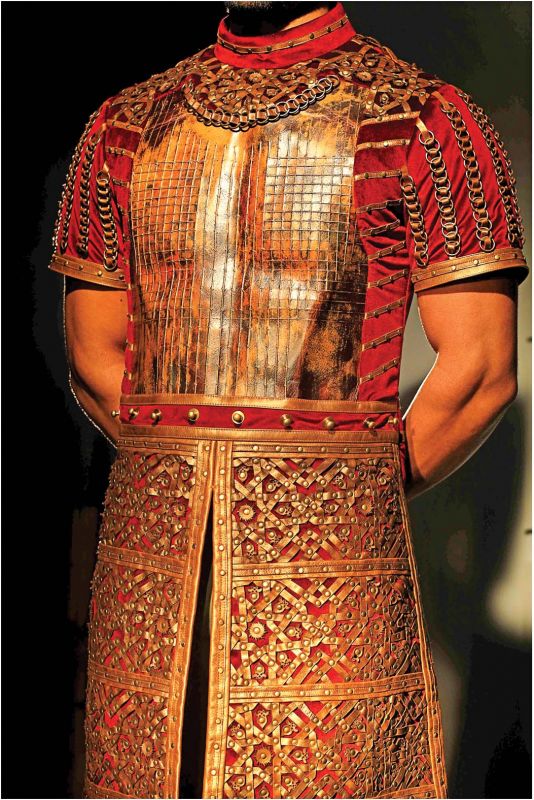Art of dressing for war

In the grim, brutal, gory battlefield, life and death are flung together in a fierce clash. The air is thick with passion and pain, hostility and destruction. But amid those fields of blood what shines bright is valour and courage. The fierce beauty of a warrior’s might. His unflinching resolve, sharp strategy. His relentless pursuit of victory. And war also has its own fashion quotient.

Ranveer Singh and Shahid Kapoor’s characters in Sanjay Leela Bhansali’s recently released Padmaavat are two interesting portrayals of warriors. And their beautifully detailed and crafted warfare wardrobe highlight how war is dressed.
The warrior armoury has been designed by artist Vipul Amar and psychologist Harsheen K. Arora, co-founders of Delhi-based design house, The V Rennaissance.
Detailing the key essentials of warfare wardrobe, Vipul says, “Warfare wardrobe needs to have its purpose at its heart — war and protection. Mobility during the fight is paramount. Intimidation is another important psychological attribute of the armoury along with portraying the character of the warrior himself. These features are a must.”
This was power dressing of a different era — a far cry from the power dressing of the corporate battlefield of present times. The sharp power suits of now are all about power of the mind, intellect, the smart hustle, the critical dealing. But armours of the past were elaborate constructs of leather and metal that reflected physical strength, prowess, stamina, power. It was the dress of the warrior who strode into the battlefield, weapons in hand, looked death straight in the eye and fought for victory. Both, and all, kinds of power dressing reflect and project might.
“The key element of any power dressing is intimidation. Also, power comes from within — what we wear augments that feeling while signifying the mood, the character, and the purpose. Clothes can be used to play an important role in having an effect on our audience by dictating how one is perceived,” says Harsheen.
The warrior is an intense, powerful character. And for a designer, much psychological study goes into understanding the characters, and translating that insight into the aesthetic crafting of his costumes. “The understanding of the characters was prime in order to achieve the looks. Once we understood that, we amalgamated it with history, era and culture. What differentiated one warrior from the other was their basic values and the contrasting reason for war. For one, it was to protect and for the other, to conquer. The emotion and reason define the psychological understanding behind the aesthetics,” explains Harsheen.
The psyche and clothes share a close correlation. Often, the dress reflects the man. And becomes an extension of him. And clothes that have seen several seasons also reflect the journey of the person. The Khilji armour before he turns Sultan incorporates the ageing and weathering the armour would have undergone through the journey across different terrains, making this journey a part of the character’s as well as the armour’s experience.
The final garment might create a look, but the little details tell their own stories. And there is much symbolism in every motif and design element used. “The Rajputana armour is adorned with geometrical patterns which stand for purpose and direction. The chest-plate has brass inlay in a pattern of 1 cm squares. Each little square contains a different shade of sand on the leather as the land of Rajputana will have during different times of the day, then the pattern converges on the sides spreading like the rays of the Sun. The brass inlay signifies the strength and valour of Rajputs and the Sun was Maharawal Ratan Singh’s insignia in the film. While, Khilji’s armour boasts of more beastly aspects with broad lion and reptile shoulders and the whole armour exudes self-glorification. Also, his armour has been created in layers suggesting that there is more to him than meets the eye,” details Vipul.
The anatomy of a warrior has a visual language all its own. The lean, whipcord Shahid and the brawny, towering Ranveer are two interesting and contrasting examples of beautiful physical power. And armours enhance that body beautiful “Armours are the second skin of the warrior,” points out Harsheen, adding, “Shahid being the loving protector, a man fighting for principles and confident of the power that he holds, did not need a hefty armour or frame. While Khilji, being a megalomaniac who believes in winning by all means, whose character invokes fear and portrays rage in order to conquer by all means, needed to be expressed through a larger than life armour boasting of his supremacy and conquest.”

